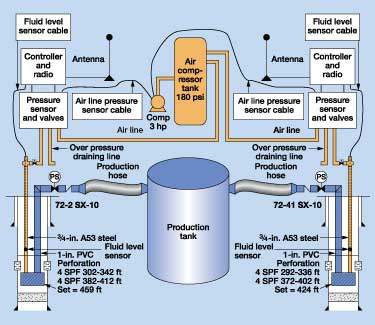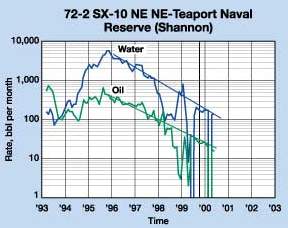Air pulse system for artificial lift reduces costs
Air pulse system for artificial lift reduces costsEd Corlew,* Petroleum Asset Management Co., Madison, Tenn., and
Joe Rochelle, U.S. Dept. of Energy, Casper, Wyo. Bottom line. In six months of testing at the Rocky Mountain Oilfield Testing Center (RMOTC), a unique air pulse lifting system, developed by Petroleum Asset Management Co. (PAMCO), lowered power consumption for lifting fluids in two shallow oil wells by 71%. Significantly, there was enough excess capacity with the 3-hp air compressor used during the test to lift similar wells with little incremental operating cost. Remote monitoring and control via satellite and web-based software were effectively demonstrated, potentially eliminating trips to the field. Problem addressed. Operators, particularly those of marginal wells, are searching for ways to lower pumping costs and improve production. Sucker rod pumping systems, although long accepted in the industry, are not without shortcomings. To maintain operational economics, proper design and maintenance are essential. Maintenance costs can be high, particularly in deviated wells subject to rod and tubing wear. PAMCO’s system provides an alternative that, when applied in the appropriate environment, will reduce lifting costs, avoid maintenance costs and, in some cases, actually improve production. The PAMCO system, with only one moving part downhole, has no sucker rods, so pulling costs are virtually eliminated. Solution. The PAMCO system consists of a downhole pump chamber with a one-way ball valve on the bottom, allowing fluid entry, and two lines – one for air / gas inlet and a small return line for producing liquid slugs to the surface. The system is computer-operated and senses filling of the downhole pump chamber. When the chamber is filled, sensors trigger the release of an air / gas pulse. This pulse, typically supplied by a small air compressor, displaces fluid in the pump chamber and lifts the liquid slug to the surface through the return line. With only one moving part (the inlet ball valve) downhole, maintenance costs are minimal. Operations can be monitored remotely and controlled via satellite through Cybersensor.com, Inc. (a strategic partner) and web-based software. The Cybersensor technology can be accessed from any computer connected to the Internet (using a password) and also provides control of tank gauges, flow meters and other peripheral equipment. The system does not fit all situations. The optimum application is for wells located relatively close together (so that one compressor can supply air for several wells), depths less than 2,000 ft and fluid volumes less than 100 bpd. It can be applied in oil wells or in marginal gas wells where it helps keep water removed. Installation. Two shallow, 500-ft wells that produce from the Shannon formation were chosen for the test. Well 72-2 was drilled in 1992 and perforated in the Shannon formation from 302 – 412 ft. Its production had declined to an average of 1 bopd and 9 bwpd. Well 72-41 was drilled in 1989 and perforated in the Shannon formation from 292 – 402 ft. Its production had declined to an average of 1 bopd and 8 bwpd. Produced oil is 36° API with a high paraffin content. Produced brine has a high scaling index. A workover rig pulled the rods and tubing from each well, and PAMCO’s pumping system was installed in each well. In this instance, 3/4-in. steel tubing was used for the inlet lines and 1-in. PVC for the return lines. A small, 3-hp compressor supplied air for both wells, Fig. 1.
The two wells were tested from October 1999 to May 2000. In both wells, production followed established declines, Fig. 2. The wells were down in March 2000 due to field electrical problems. The system operated reliably throughout the Wyoming winter. There were no well pulling costs nor unusual maintenance costs. Paraffin and scale from produced fluids did not cause any operational problems throughout the test.
Remote monitoring and control of the wells were accomplished through a built-in satellite link connected to the wellsite. Proprietary web-based software, with access to the wellsite over the Internet, also was tested effectively. Remote, near-real-time alarm and messaging was available at very low cost via Cybersensor.com using an existing low-earth-orbit satellite system (ORBCOMM). Economic performance. The single, 3-hp compressor was able to lift the wells and still run only 25% of the time, indicating that there was sufficient excess capacity to lift additional wells with little incremental cost. Prior to the test, Well 72-41 was produced using an API size 25 pumping unit with a 3-hp motor on a 25% time clock. Well 72-2 was produced using an API size 57 pumping unit with a 7.5-hp motor on a 25% time clock. Electrical power cost averaged $16/month during the test period, a 71% reduction in power costs, compared to combined average power cost for the two wells of $56/month. The PAMCO system, including the controller and Cybersensor.com automation and communications system, would cost about $7,500 for a single-well installation in a typical 1,000-ft deep well. It must be noted that, as in the RMOTC installation, one compressor may supply enough air for several wells. Leasing rather than purchasing is also an option. Other benefits, not apparent in this small-scale field test, are that production often is increased when wells are kept pumped off or clear of fluids and well servicing costs are reduced. With automation, field labor costs can be lowered.
|
||||||||||||||||




